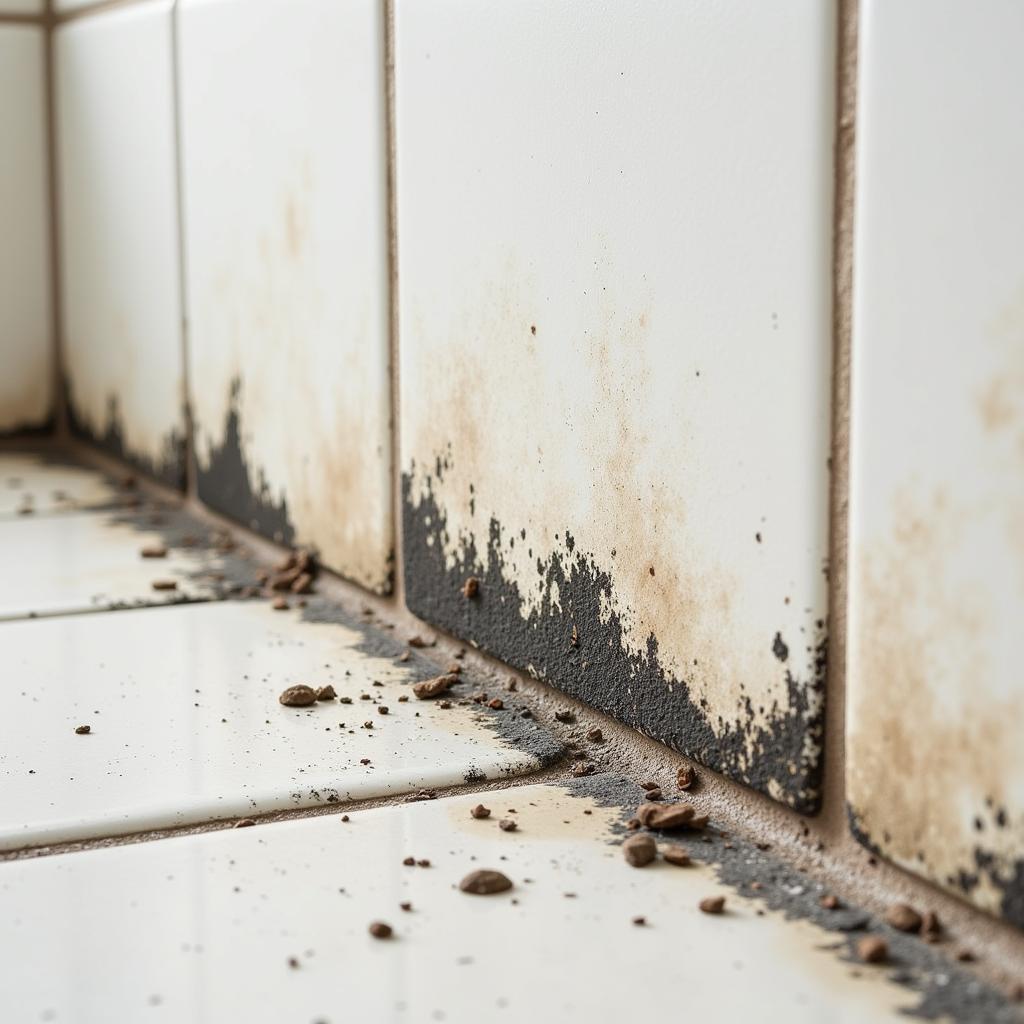An exhaust fan is an essential component of any comfortable and healthy living space. It removes excess moisture, odors, and pollutants, ensuring good air quality and preventing the growth of mold and mildew. With so many options available, selecting the right exhaust fan for your room can seem daunting. This comprehensive guide will walk you through everything you need to know about exhaust fans, helping you make an informed decision for a fresher and healthier home.
Understanding Exhaust Fans: Why They Matter
Before we dive into the specifics of choosing an exhaust fan, let’s understand why they are so crucial. Imagine taking a hot shower – the bathroom mirror fogs up, and the air feels heavy and humid. This excess moisture doesn’t just disappear; it lingers in the air and settles on surfaces, creating a breeding ground for mold and mildew. Over time, this can lead to unpleasant odors, respiratory problems, and even structural damage.
 Bathroom Mold Growth Due to Poor Ventilation
Bathroom Mold Growth Due to Poor Ventilation
This is where exhaust fans come in. By expelling the humid air outside and drawing in fresh air, they help regulate moisture levels, prevent mold growth, and maintain a healthy environment. But the benefits don’t stop there. Exhaust fans also eliminate cooking odors, smoke, and other airborne pollutants, ensuring your home stays fresh and odor-free.
Factors to Consider When Choosing an Exhaust Fan
Now that you understand the importance of exhaust fans, let’s explore the key factors to consider when choosing one for your specific needs:
1. Room Size and Ceiling Height
The size of your room and the height of your ceiling are crucial factors in determining the appropriate fan size. A fan that’s too small for the space won’t effectively ventilate the area, while an oversized fan will be noisy and inefficient.
How to Determine the Right Fan Size:
Exhaust fan capacity is measured in cubic feet per minute (CFM). To determine the CFM required for your room, follow these simple steps:
- Calculate the room’s volume: Multiply the room’s length, width, and height.
- Determine the recommended air changes per hour (ACH): Bathrooms typically require 8-10 ACH, while kitchens need around 5-7 ACH. You can consult building codes for specific recommendations in your area.
- Calculate the CFM: Divide the room’s volume by 60 (minutes in an hour) and multiply it by the recommended ACH.
For example, for a bathroom that’s 10 feet long, 8 feet wide, and 8 feet high, with a recommended ACH of 8:
- Room volume: 10ft x 8ft x 8ft = 640 cubic feet
- CFM: (640 / 60) x 8 = 85.33 CFM (round up to 90 CFM)
 Measuring Bathroom Dimensions for Exhaust Fan
Measuring Bathroom Dimensions for Exhaust Fan
2. Noise Level (Sones)
Exhaust fans can vary significantly in terms of noise output. Imagine a loud, whirring fan constantly interrupting your relaxing bath or shower – not exactly ideal! Noise levels are measured in sones, with lower sones indicating quieter operation.
Choosing the Right Sone Level:
- For bathrooms: Aim for fans with a sone rating of 1.0 or lower for quiet operation.
- For kitchens: Fans with sone ratings between 3.0 and 4.0 are generally acceptable, as kitchens tend to have more ambient noise.
3. Features and Options
Modern exhaust fans come equipped with a range of features that enhance their functionality and convenience:
- Humidity sensors: Automatically turn the fan on when humidity levels rise, ensuring optimal moisture control.
- Motion sensors: Activate the fan when motion is detected, making them perfect for bathrooms and laundry rooms.
- Timers: Allow you to set the fan to run for a specific duration, ensuring adequate ventilation even after you leave the room.
- Lights: Many exhaust fans come with built-in lights, providing illumination and ventilation in one unit.
- Bluetooth speakers: Some models even feature Bluetooth speakers, allowing you to enjoy your favorite music while you shower or bathe.
Installation and Maintenance
While choosing the right exhaust fan is crucial, proper installation and regular maintenance are equally important for optimal performance and longevity.
Installation:
It’s always recommended to hire a qualified electrician for exhaust fan installation. They will ensure:
- Proper electrical connections.
- Secure mounting of the fan unit.
- Correct venting to the outside of the house, preventing moisture from being trapped in the attic or walls.
Maintenance:
Regular cleaning and maintenance will keep your exhaust fan running smoothly for years to come:
- Clean the fan blades and housing: Dust and debris can accumulate on the fan blades, reducing efficiency and increasing noise levels. Regularly vacuum or wipe down the blades and housing.
- Check the motor lubrication: Consult your fan’s manual for lubrication recommendations.
- Inspect the ductwork: Ensure the ductwork is free of obstructions and properly connected to the fan.
Conclusion
Investing in a quality exhaust fan is essential for maintaining a healthy and comfortable living environment. By understanding the factors discussed in this guide and considering your specific needs, you can choose the right exhaust fan to keep your home fresh, odor-free, and free from excess moisture. Remember, a well-ventilated home is a happy and healthy home!
Frequently Asked Questions about Exhaust Fans
1. How long should I run my bathroom exhaust fan after a shower?
It’s generally recommended to run your bathroom exhaust fan for at least 20-30 minutes after a shower to effectively remove excess moisture. If you have a timer function, you can set it accordingly.
2. Can I install an exhaust fan myself?
While it’s possible to install an exhaust fan yourself, it’s always recommended to hire a qualified electrician, especially if you’re not comfortable working with electrical wiring. Improper installation can lead to safety hazards and void your fan’s warranty.
3. What is the average lifespan of an exhaust fan?
With proper maintenance, a well-maintained exhaust fan can last for 10-15 years or even longer.
4. Can an exhaust fan help reduce energy costs?
Yes, an exhaust fan can indirectly contribute to reducing energy costs. By removing humidity, it can lessen the load on your air conditioner, as drier air requires less energy to cool.
5. What is the difference between an exhaust fan and a ceiling fan?
While both involve rotating blades, their functions differ significantly. Exhaust fans expel stale air outside, while ceiling fans circulate air within a room for improved comfort.
6. What are some signs that my exhaust fan needs to be replaced?
If your exhaust fan is excessively noisy, vibrates excessively, fails to remove moisture effectively, or emits a burning smell, it’s likely time for a replacement.
7. Can I vent my exhaust fan into the attic?
No, venting an exhaust fan into the attic is not recommended. It can lead to moisture buildup in the attic, potentially causing mold growth, wood rot, and insulation damage. Always vent your exhaust fan directly outdoors.
Need Help Choosing the Perfect Exhaust Fan?
Choosing the right exhaust fan for your needs can be a breeze with the help of our experts. Contact us at Phone Number: 0903426737, Email: fansbongda@gmail.com, or visit us at Address: Group 9, Zone 6, Gieng Day Ward, Ha Long City, Quang Ninh, Vietnam. Our dedicated team is available 24/7 to assist you with all your exhaust fan needs. We also have other helpful articles on our website, like bathroom exhaust fan 100 cfm and how to change bulb in bathroom exhaust fan. You can learn more about specific exhaust fan issues and solutions, like bathroom exhaust fan not removing steam or even find bathroom exhaust fan repair near me. We’re here to help you create a fresher, healthier, and more comfortable home.


